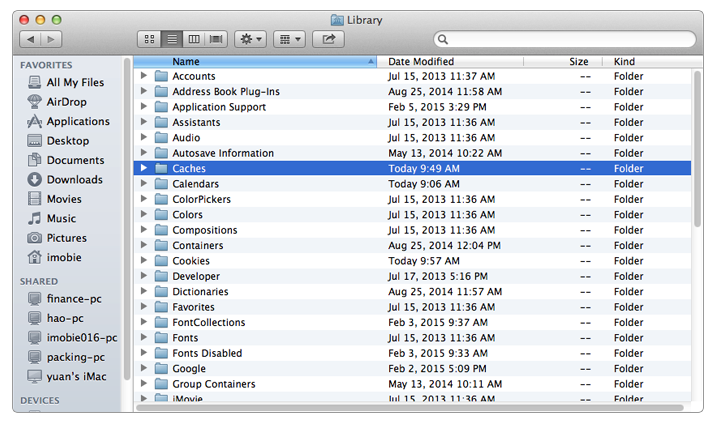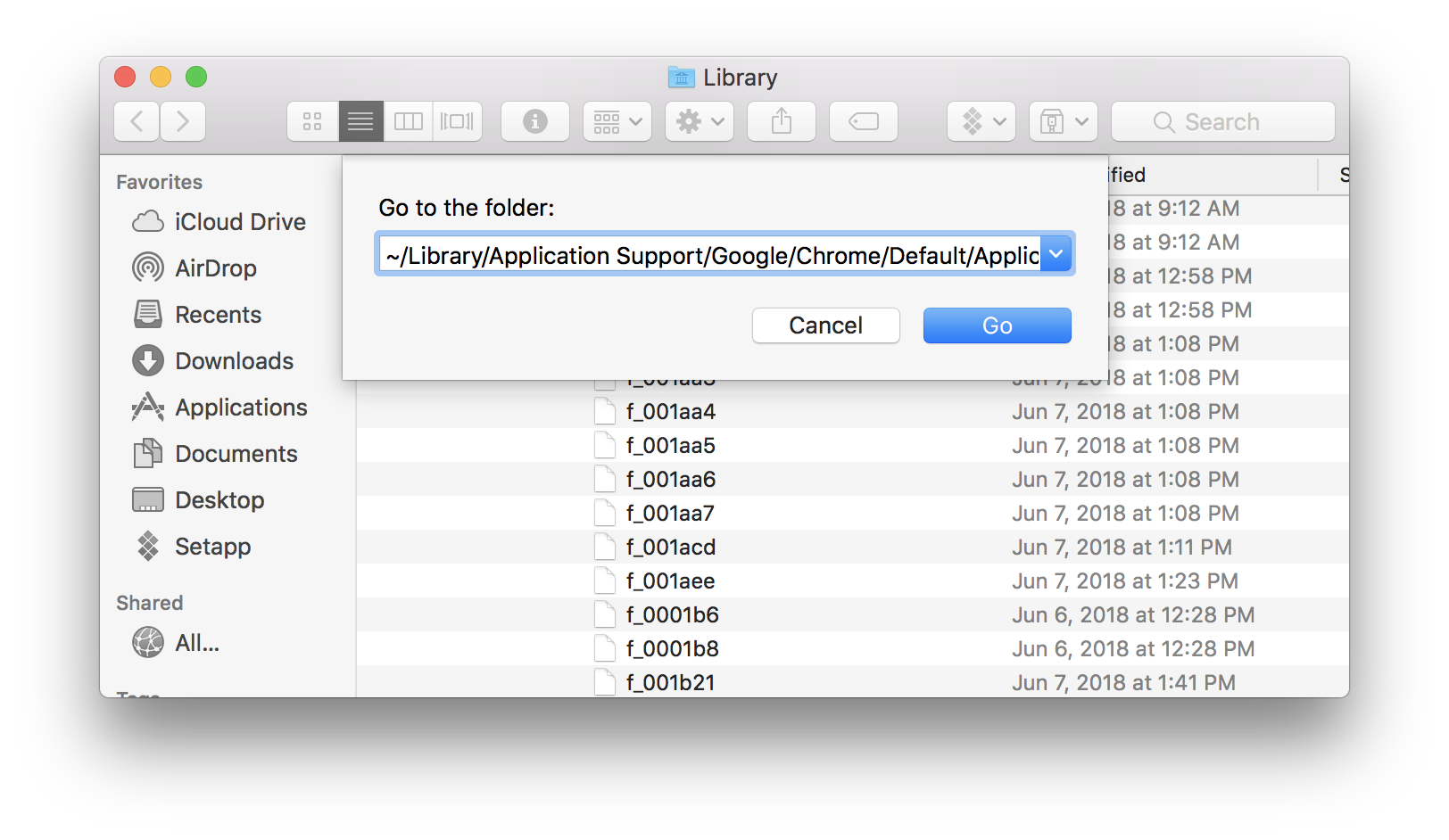- How To Clear Mac Library Cache Firefox
- Delete Library Cache Mac
- What Are Caches
- How To Clear Mac Library Cache Lake
- How To Clear Mac Library Cache Windows 7
- How To Clear Mac Library Cache Mode
Optimized Storage in macOS Sierra and later* can save space by storing your content in iCloud and making it available on demand. When storage space is needed, files, photos, movies, email attachments, and other files that you seldom use are stored in iCloud automatically. Each file stays right where you last saved it, and downloads when you open it. Files that you’ve used recently remain on your Mac, along with optimized versions of your photos.
* If you haven't yet upgraded to macOS Sierra or later, learn about other ways to free up storage space.
Mac c dynamic library example template. The difference between.dylib and.so on mac os x is how they are compiled. For.so files you use -shared and for.dylib you use -dynamiclib. Both.so and.dylib are interchangeable as dynamic library files and either have a type as DYLIB or BUNDLE.
Oct 07, 2019 The initial macOS Catalina Beta only opens the previously selected iTunes Library on your Mac. Before you install the macOS Catalina Beta, choose the iTunes Library that you want to use on your test computer: In the iTunes app on your Mac, choose iTunes Quit iTunes. Hold down the Option key while you open iTunes. Create alternate itunes library mac.
Jun 19, 2018 To free up disk space, it’s helpful to know exactly what is using disk space on your Mac. A hard disk analysis tool like Disk Inventory X will scan your Mac’s hard disk and display which folders and files are using up the most space. You can then delete these space hogs to free up space. By far the best is to clear the cache on Mac OS Mojave. This will provide increased storage space that can be utilized to make the Mac operations more efficient. When you decide to clear the cache, there are two options; manual or the use of third-party software like CleanMyMac X. The latter is the preferred option. Oct 07, 2019 How to free up storage space on your Mac Save space by storing your content in iCloud or using built-in tools to find and remove large or unneeded files. Optimized Storage in macOS Sierra and later. can save space by storing your content in iCloud and making it available on demand. Apr 18, 2017 How to Clean All Caches and Temporary Files from Mac. Quit out of any actively open Mac apps. Go to the Finder in Mac OS. Hold down the SHIFT key (in Sierra) or OPTION / ALT key (Earlier) and pull down the “Go” menu in the Finder. Choose “Library” from the Go menu options. Once inside the Library. Oct 23, 2017 It is always advisable to clear your cache to improve your Mac performance. There are mainly three types of cache in your Mac namely Browser cache, User cache, and System cache. Here we will clear all the cache to improve Mac performance. Well, there are two ways to delete cache.
We explained in another tutorial, but there's an easier way to access one of most important hidden folders on your Mac, called the Library folder.The user's Library folder, which is different than the root Library folder at the top-level of the hard drive, contains hundreds files that store important preferences and settings for many of the applications on your Mac. https://omgapt.netlify.app/how-to-access-user-library-on-mac.html. It's good to learn how to access this folder, even if you don't need to open it right now.Here's how to access the Library folder in OS X 10.7 Lion and 10.8 Mountain Lion:.
Find out how much storage is available on your Mac
- To clear your user cache, do the following: Open a Finder window and select “Go to Folder” in the Go menu. Type in /Library/Caches and hit enter to proceed to this folder. Optional step: You can highlight and copy everything to a different folder just in case something goes wrong. Go into each of.
- Feb 16, 2011 Storing data in cache makes your Mac run faster because it can obtain the data quickly. Sometimes the cache gets corrupt, though, because of software updates, conflicts, and unexpected quits, and this can cause problems. Find out how to delete the library cache occasionally to maintain your Mac’s performance.+ +How to Delete Cache+.
Choose Apple menu > About This Mac, then click Storage. This is an overview of available storage space on your Mac, as well as the space used by different categories of files:
Click the Manage button to open the Storage Management window, pictured below. (The Manage button is available only in macOS Sierra or later.)
Manage storage on your Mac

The Storage Management window offers recommendations for optimizing your storage. If some recommendations are already turned on, you will see fewer recommendations.
Store in iCloud
Click the Store in iCloud button, then choose from these options:
- Desktop and Documents. Store all files from these two locations in iCloud Drive. When storage space is needed, only the files you recently opened are kept on your Mac, so that you can easily work offline. Files stored only in iCloud show a download icon , which you can double-click to download the original file. Learn more about this feature.
- Photos. Store all original, full-resolution photos and videos in iCloud Photos. When storage space is needed, only space-saving (optimized) versions of photos are kept on your Mac. To download the original photo or video, just open it.
- Messages. Store all messages and attachments in iCloud. When storage space is needed, only the messages and attachments you recently opened are kept on your Mac. Learn more about Messages in iCloud.
How To Clear Mac Library Cache Firefox
Storing files in iCloud uses the storage space in your iCloud storage plan. If you reach or exceed your iCloud storage limit, you can either buy more iCloud storage or make more iCloud storage available. iCloud storage starts at 50GB for $0.99 (USD) a month, and you can purchase additional storage directly from your Apple device. Learn more about prices in your region.
Optimize Storage
Click the Optimize button, then choose from these options.
- Automatically remove watched movies and TV shows. When storage space is needed, movies or TV shows that you purchased from the iTunes Store and already watched are removed from your Mac. Click the download icon next to a movie or TV show to download it again.
- Download only recent attachments. Mail automatically downloads only the attachments that you recently received. You can manually download any attachments at any time by opening the email or attachment, or saving the attachment to your Mac.
- Don't automatically download attachments. Mail downloads an attachment only when you open the email or attachment, or save the attachment to your Mac.
Delete Library Cache Mac
Optimizing storage for movies, TV shows, and email attachments doesn't require iCloud storage space.
Empty Trash Automatically
Empty Trash Automatically permanently deletes files that have been in the Trash for more than 30 days.
Reduce Clutter
Reduce Clutter helps you to identify large files and files you might no longer need. Click the Review Files button, then choose any of the file categories in the sidebar, such as Applications, Documents, Music Creation, or Trash.

You can delete the files in some categories directly from this window. Other categories show the total storage space used by the files in each app. You can then open the app and decide whether to delete files from within it.
Learn how to redownload apps, music, movies, TV shows, and books.
Where to find the settings for each feature
The button for each recommendation in the Storage Management window affects one or more settings in other apps. You can also control those settings directly within each app.
- If you're using macOS Catalina, choose Apple menu > System Preferences, click Apple ID, then select iCloud in the sidebar: Store in iCloud turns on the Optimize Mac Storage setting on the right. Then click Options next to iCloud Drive: Store in iCloud turns on the Desktop & Documents Folders setting. To turn off iCloud Drive entirely, deselect iCloud Drive.
In macOS Mojave or earlier, choose Apple menu > System Preferences, click iCloud, then click Options next to iCloud Drive. Store in iCloud turns on the Desktop & Documents Folders and Optimize Mac Storage settings. - In Photos, choose Photos > Preferences, then click iCloud. Store in iCloud selects iCloud Photos and Optimize Mac Storage.
- In Messages, choose Messages > Preferences, then click iMessage. Store in iCloud selects Enable Messages in iCloud.
- If you're using macOS Catalina, open the Apple TV app, choose TV > Preferences from the menu bar, then click Files. Optimize Storage selects “Automatically delete watched movies and TV shows.”
In macOS Mojave or earlier, open iTunes, choose iTunes > Preferences from the menu bar, then click Advanced. Optimize Storage selects “Automatically delete watched movies and TV shows.” - In Mail, choose Mail > Preferences from the menu bar, then click Accounts. In the Account Information section on the right, Optimize Storage sets the Download Attachments menu to either Recent or None.
Empty Trash Automatically: From the Finder, choose Finder > Preferences, then click Advanced. Empty Trash Automatically selects “Remove items from the Trash after 30 days.”
Other ways that macOS helps automatically save space
With macOS Sierra or later, your Mac automatically takes these additional steps to save storage space: Unlock library folder mac.
- Detects duplicate downloads in Safari, keeping only the most recent version of the download
- Reminds you to delete used app installers
- Removes old fonts, languages, and dictionaries that aren't being used
- Clears caches, logs, and other unnecessary data when storage space is needed
What Are Caches
How to free up storage space manually
Even without using the Optimized Storage features of Sierra or later, you can take other steps to make more storage space available:
Mac mla library. The Mid-Atlantic Chapter of the Medical Library Association (MAC- MLA) is an organization of health sciences librarians and other information professionals serving the District of Columbia, Maryland, North Carolina, Virginia, Western Pennsylvania, and West Virginia.
How To Clear Mac Library Cache Lake
- Music, movies, and other media can use a lot of storage space. Learn how to delete music, movies, and TV shows from your device.
- Delete other files that you no longer need by moving them to the Trash, then emptying the Trash. The Downloads folder is good place to look for files that you might no longer need.
- Move files to an external storage device.
- Compress files.
- Delete unneeded email: In the Mail app, choose Mailbox > Erase Junk Mail. If you no longer need the email in your Trash mailbox, choose Mailbox > Erase Deleted Items.
How To Clear Mac Library Cache Windows 7
Learn more
How To Clear Mac Library Cache Mode
- When you duplicate a file on an APFS-formatted volume, that file doesn't use additional storage space on the volume. Deleting a duplicate file frees up only the space required by any data you might have added to the duplicate. If you no longer need any copies of the file, you can recover all of the storage space by deleting both the duplicate and the original file.
- If you're using a pro app and Optimize Mac Storage, learn how to make sure that your projects are always on your Mac and able to access their files.